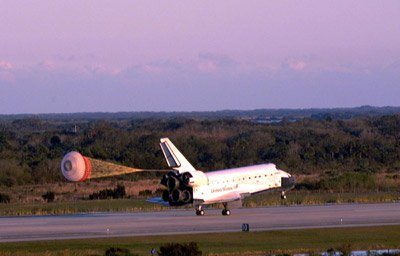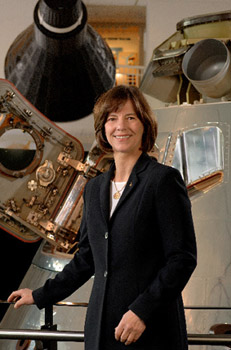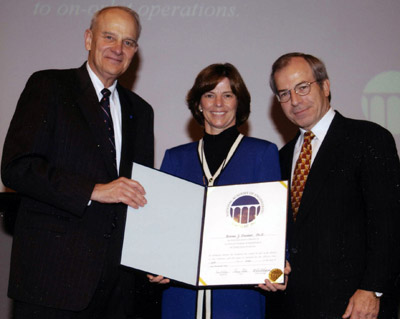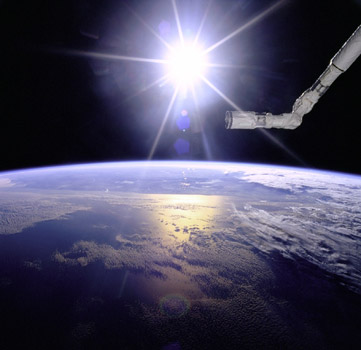The Final Flight
In 1998, Bonnie Dunbar prepared for her final voyage to space and her second trip
to Mir. The mission to the Russian Space Station was widely considered one of the
most successful, says Wilcutt, Mission Commander of the flight (STS-89). During
the eight-day flight, the crew conducted an astronaut exchange. Dunbar, Payload
Commander, oversaw 23 different experiments to advance design and safety of the
International Space Station.
More than a decade later, America is reaping the benefits of Dunbar's final flight.
The International Space Station is inhabited, under construction, and Dunbar says
vital to the future of space exploration.
 Endeavour carries Bonnie Dunbar on her
last mission to space in 1998. "She left a legacy of integrity at NASA," says a
colleague. STS-89. NASA photo.
Endeavour carries Bonnie Dunbar on her
last mission to space in 1998. "She left a legacy of integrity at NASA," says a
colleague. STS-89. NASA photo.
"That is the only place that kind of laboratory can exist. There is no microgravity
on the surface of Earth. Why is it international? Because all of those nations understand
that's the only place that lab can exist and we’ve created an international partnership.
We share a common goal -- to learn more about science on Earth and improve our quality
of life.”
Her Greatest Chapter
Back on the planet following that 1998 mission (STS-89), Dunbar spent the next seven
years in Senior Executive Service (SES) at NASA. By the time she retired, the five-time
space hero had given the agency nearly three decades of her life.
"She's a remarkable scientist and astronaut who happens to be a woman," sums up
Colonel Wilcutt. "She helped cement a place for women in space and left a legacy
at NASA of integrity and professionalism," Wilcutt continues, crediting Dunbar with
"moral courage." She has "never been afraid to stand up for the ‘right thing' -
even at the risk of jeopardizing her career," he says.
 Dunbar begins a new chapter leading Seattle's
Museum of Flight. Museum of Flight photo.
Dunbar begins a new chapter leading Seattle's
Museum of Flight. Museum of Flight photo.
Dunbar holds it all sacred - the training, the exploration, and the army of unsung
heroes at NASA who day in and day out help the nation conquer space.
"We would have never have reached the Moon without these hundreds of thousands of
unsung heroes," says Dunbar. "They're everyone from the people the in the office
who managed your letters and your phone calls, to the engineer out on the floor,
to the manager or administrator justifying funding for space exploration from Congress
and the Administration. They are all unsung heroes."
Eventually, Dunbar returned to her Washington roots as enthused as ever about the
next chapter.
Down the block from The Boeing Company where her remarkable career began, Dunbar
today oversees one of the world's most exceptional air and space museums. Her passion
for the country's lone human spaceflight program remains vibrant. "We didn't get
to the Moon by accident," she says of America's need to push farther into space.
More than 10 years have passed now since Dunbar rocketed into orbit. As President
and CEO of the Museum of Flight in Seattle, Dunbar hopes to lead future engineering,
science, and space heroes closer to their dreams. She's building her "SRU," as she
calls it, or "Self Replacement Unit."
"When you invest in technology and lead, it translates right back into the quality
of life for every American and their influence in the geopolitical environment,"
says Dunbar. "In some ways, it can help promote democracy."
 Induction into National Academy of Engineering (NAE) in 2002. Dunbar personal collection.”
Induction into National Academy of Engineering (NAE) in 2002. Dunbar personal collection.”
Dunbar is living in the Seattle area and embracing Washington life. Despite her
busy schedule, she makes time to travel to Scotland to see family and visits her
mother regularly out on the cattle ranch in the Yakima Valley. Dunbar still keeps
in close contact with her sister, who teaches school in Florida. "Until a couple
of years before my dad passed away, we were still doing roundup and many of my friends
from college would come,” she explains.
Still supportive of NASA, the Washingtonian remains committed to energizing the
nation and the future of human spaceflight. Today India, China, Japan, Russia, and
Europe are all developing human space exploration programs, she says. The U.S. hopes
to return humans to the Moon by 2020.
"I think it returns us to a fundamental question -- are we a space-faring nation
or are we not?" Dunbar says. "If you’re saying no, then let the Sun set on our civilization.
We'll sit back and be a nation of watchers and not doers. Our quality of life will
not quite be the same and we could even become another Third World country. But
if the answer is yes, you have to ask yourself how do we move forward? We invest
in education. We invest in research. We invest in technology. Crucially, we need
the courage to try. Since its inception, our nation has benefitted greatly from
people who found the courage to lead."
 The beauty of Earth captured from space.
NASA photo.
The beauty of Earth captured from space.
NASA photo.
Dunbar has lived a lifetime trying, and every stretch of it has paid off in spades.
All told, she's logged 50 days, 7 hours, 40 minutes and 26 seconds in space. That's
enough time to orbit Earth 800 times and travel 200-million miles (321,868,800 km)
in space.
She's spent hundreds of hours piloting single engine aircraft and co-piloting T-38
trainer jets. In 1995, she qualified for lengthy missions aboard Space Station Mir.
She flew five space missions for NASA and held several posts with the space agency
including Assistant Director of the Johnson Space Center and Deputy Associate Administrator,
Office of Life and Microgravity Sciences, at NASA Headquarters. Dunbar was inducted
into the Women in Technology International Hall of Fame in 2000 and the National
Academy of Engineering in 2002. Dr. Dunbar is an Associate Fellow in the American
Institute of Aeronautics and Astronautics.
From her days on the cattle ranch near Outlook, Dunbar remains a living testament
to the power of optimism and the human spirit. Despite all that she has accomplished,
does it rankle that she's never been on the Moon herself? The astronaut shrugs.
"You can waste a lot of energy being disappointed about things you didn't get to
do. I'm a glass is half-full person. The fact that I was able to fly an airplane
is pretty remarkable to me."
She'd follow her heart on the same journey, she says, but would try and lead a better
life.
"When I was young, I thought that people were invincible. Until my brother was killed
in Vietnam, I was never exposed to human death. I realized then that we are temporarily
on this Earth and how important it is to thank people along the way. There are times
I wished that I had slowed down and thanked people before suddenly they were gone."
 With parents flying "Mooney" across the
U.S. in 1986.
With parents flying "Mooney" across the
U.S. in 1986.
Dunbar personal collection.
But in true Dunbar fashion, the farm girl-turned-astronaut is moving forward without
looking back, hoping to land one of NASA's retiring Space Shuttles for the Museum
of Flight and inspire a new generation to take on science and follow its dreams.
"We owe it to civilization and the future to explore, educate, and keep an open
mind. You can substitute any career for astronaut, or any business. You just have
to commit yourself to it and not be deterred by other people or obstacles. Believe
in it. Recognize that there will be ups and downs. No path is ever straight, nor
is it ever easy. My career wasn’t easy at times. But if you believe in your calling,
if it excites you when you wake up in the morning, why would you make another choice?
Why would you choose something that doesn’t make life worth living? The journey
alone will be worthwhile."
Trova Heffernan, The Legacy Project, 2009